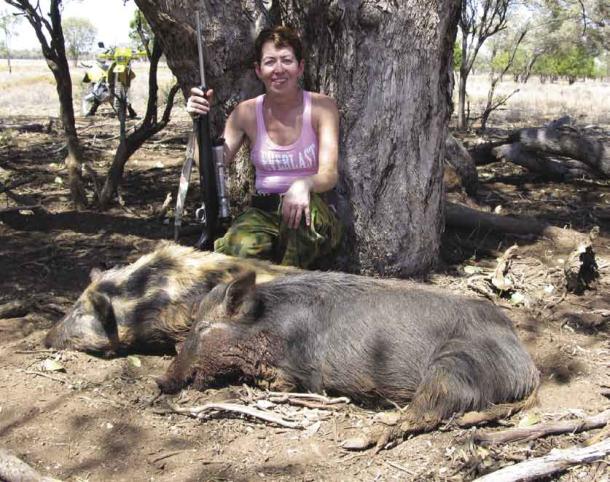The Culgoa River and its surrounding floodplain is a mecca for pigs (especially after flooding rains) and provides pig hunters on a budget with arguably some of the most reliable hunting opportunities in Australia without the cost of a Cape York safari.
The Culgoa River is central to the Murray-Darling Basin system. The river commences its journey after leaving the Balonne River (in the country to the north of Dirranbandi) before meandering its way throughout the vast pastoral areas of south west Queensland and emptying into the Darling River above Bourke NSW.
For the majority of the year the river simply consists of a series of deep waterholes, however; in a good year it can become a ranging torrent with river heights in Western NSW of more than 6 metres. During these periods the river has a tendency to break its banks inundating the adjacent black soil flood plains, which can result in landowners being marooned for weeks on end and pigs being attracted to the area like bees to a honey pot. In this regard it is not unusual to find well used and baited pig traps dotted throughout the rivers’ flood plain as landowners try to manage the inevitable explosion in the feral pig population that occurs following periods of flooding. On some occasions (like our recent visit), pigs can even be found in traps that haven’t even been baited!
The topography of the rivers system ideally lends itself to hunting on foot or by motorcycle. The combination of Coolabah tree deadfall and gullies, which extend out from the main watercourse for kilometres largely prevents conventional 4WD vehicles from getting into where the action is. Even quads can find it tough when negotiating the river course but come into their own once pigs move out onto the adjoining flood plain.

These pair of Culgoa refugees were no match for Sandy and her 7MM-08 when they were found camped on a nearby sand hill.
It was October and Sandy, BI and I were only too happy to accept our friend’s invitation to cull the emerging pig population on their 72,000 acre sheep and cattle station following earlier heavy rains in the Bourke district.
We were up before daylight on our first day of hunting and decided that it would be best to do an early check of the floodplain as the owner had advised that many of the swamps still held water. The information proved sound as we’d only just entered a nearby paddock when I spooked a boar that was feeding amongst the lignum. The bark of the .270 broke the early morning solitude as the boar capsized sideways into the water.
We’d no sooner finished taking photographs then BI called out over the radio that he “was onto a decent boar” and within five minutes our tally was two for two. Not to be outdone, Sandy who was scouring the timberline on her quad called to advise that she’d also been successful in disposing of a boar that was laying doggo amongst the Mulga.
By lunch time we’d accounted for 12 pigs after giving a mob of nine a run for their money as they took every opportunity to make good their escape by seeking refuge in the every bit of available scrub in the 8000 acre paddock. Their luck came to an end when they broke cover and attempted to cross a clay pan only to be picked off by some devastatingly accurate shots from Sandy and BI’s respective Remington 700’s.
The afternoon found us weaving our way along the Culgoa where we were constantly inconvenienced by the behaviour of the large mobs of feral goats which inhabit the area. Goats can be a nuisance when hunting pigs as they will avoid crossing even the smallest amount of water and instead tend to constantly bleat and run along the river bank alarming pigs in the process. To try and mitigate the impact of the goats, BI and I dismounted several hundred metres prior to a deep bend and stalked into an area littered with Red Gum deadfall, a known refuge for some of the property’s larger boars. We hadn’t long entered the bend when three large pigs broke cover from a clump of deadfall and we cursed our luck as they were quickly obscured by a mob of passing goats, which prevented us from taking a shot.
As we returned to our bikes BI called over the radio “Stop, I’m onto one”! His warning was soon drowned out by the echo of the .270 as the noise of its discharge reverberated through the trees. An investigation of BI’s quarry revealed a large 80 kg sow, which had been lying doggo underneath a large log and made no effort to move despite BI being within 20 metres of its location. After taking the obligatory photos we made our way back to camp happy in the knowledge that 13 less pigs would be preying on the livestock.
The following morning found us scouring the flood plain when Sandy noticed a large boar feeding amongst the Mitchell Grass. It was apparent that the pig was anxious to return to the sanctuary of the Culgoa and immediately hit top gear. Not to be outdone, Sandy gunned her Polaris and was soon in hot pursuit before dismounting and pole-axing the boar as it ran past her position.
It wasn’t long before our long weekend came to an end and we reluctantly bid farewell to our hosts after accounting for 32 pigs in three days.
The biggest challenge facing hunters wishing to hunt the Culgoa is not finding pigs but gaining property access. While many property gates are now adorned with brass padlocks and “No Hunting” signs (largely due to the activities of thoughtless poachers) opportunities remain available for those responsible hunters who are prepared to approach landholders with a view to performing work in return for hunting access.
0 Comments